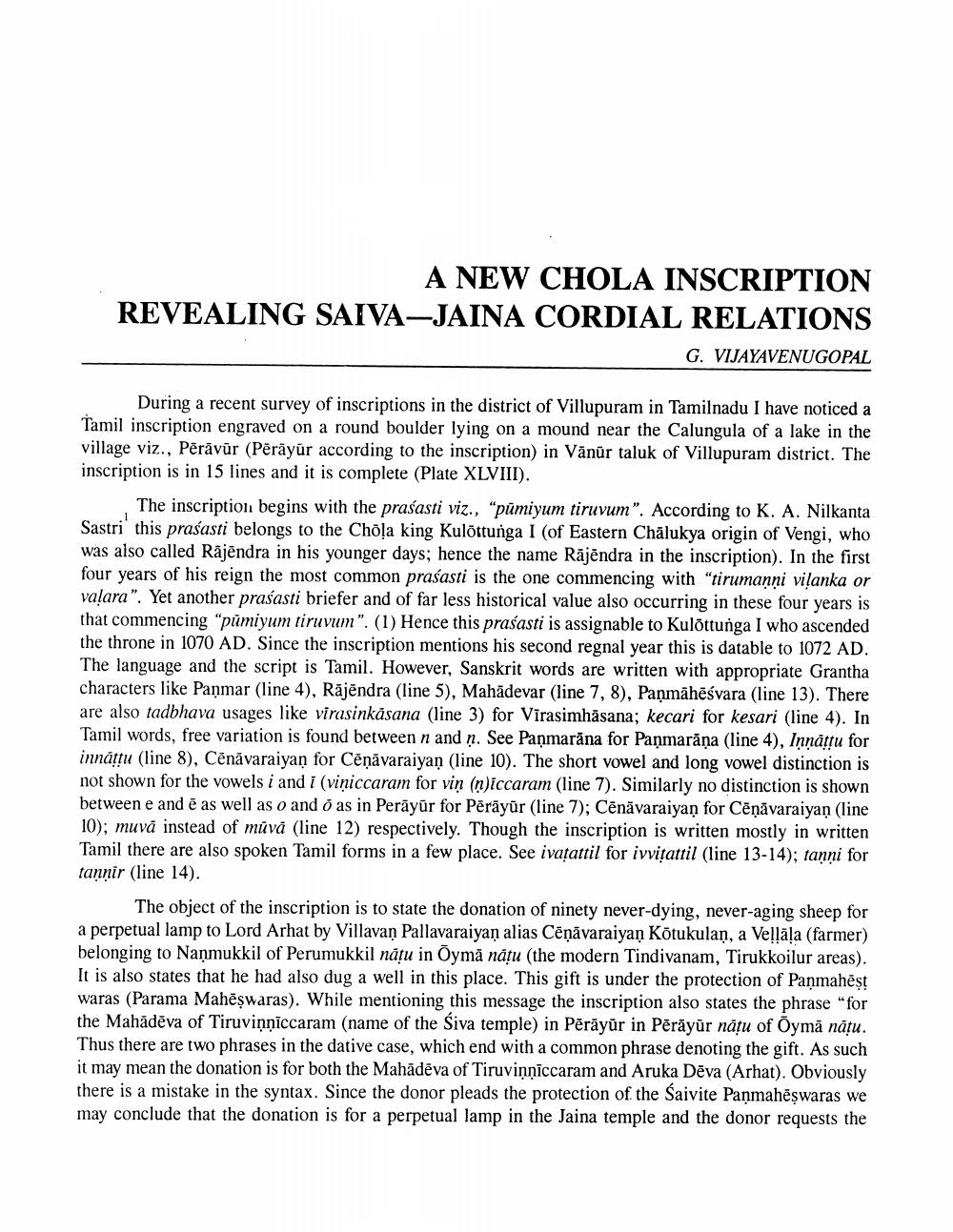________________
A NEW CHOLA INSCRIPTION REVEALING SAIVA-JAINA CORDIAL RELATIONS
G. VIJAYAVENUGOPAL
During a recent survey of inscriptions in the district of Villupuram in Tamilnadu I have noticed a Tamil inscription engraved on a round boulder lying on a mound near the Calungula of a lake in the village viz., Pêravür (Peräyür according to the inscription) in Vănûr taluk of Villupuram district. The inscription is in 15 lines and it is complete (Plate XLVIII).
The inscription begins with the prasasti viz.. "pâmiyum tiruvum". According to K. A. Nilkanta Sastri' this prasasti belongs to the Chola king Kulöstunga I (of Eastern Chalukya origin of Vengi, who was also called Rajendra in his younger days; hence the name Rajendra in the inscription). In the first four years of his reign the most common prasasti is the one commencing with "tirumanni vilanka or valara". Yet another prasasti briefer and of far less historical value also occurring in these four years is that commencing "pumiyum tiruvum". (1) Hence this prasasti is assignable to Kulottunga I who ascended the throne in 1070 AD. Since the inscription mentions his second regnal year this is datable to 1072 AD. The language and the script is Tamil. However, Sanskrit words are written with appropriate Grantha characters like Panmar (line 4), Rajendra (line 5), Mahadevar (line 7, 8), Panmäheśvara (line 13). There are also tadbhava usages like virasinkäsana (line 3) for Vīrasimhasana; kecari for kesari (line 4). In Tamil words, free variation is found between n and n. See Panmarāna for Panmarāna (line 4), Innáttu for innáttu (line 8), Cenävaraiyan for Cenävaraiyan (line 10). The short vowel and long vowel distinction is not shown for the vowels i and I (viniccaram for vin (n)Iccaram (line 7). Similarly no distinction is shown between e and è as well as o and ó as in Peräyûr for Peräyûr (line 7); Cenävaraiyan for Cenävaraiyan (line 10); muvd instead of mavá (line 12) respectively. Though the inscription is written mostly in written Tamil there are also spoken Tamil forms in a few place. See ivatattil for ivvitattil (line 13-14); tanni for tannir (line 14).
The object of the inscription is to state the donation of ninety never-dying, never-aging sheep for a perpetual lamp to Lord Arhat by Villavan Pallavaraiyan alias Cēṇāvaraiyan Kötukulan, a Vellala (farmer) belonging to Nanmukkil of Perumukkil natu in Oyma nafu (the modern Tindivanam, Tirukkoilur areas). It is also states that he had also dug a well in this place. This gift is under the protection of Panmaheṣṭ waras (Parama Maheswaras). While mentioning this message the inscription also states the phrase "for the Mahadeva of Tiruvinniccaram (name of the Siva temple) in Péräyür in Peräyür nätu of Oyma naju. Thus there are two phrases in the dative case, which end with a common phrase denoting the gift. As such it may mean the donation is for both the Mahādēva of Tiruvinniccaram and Aruka Dēva (Arhat). Obviously there is a mistake in the syntax. Since the donor pleads the protection of the Saivite Panmaheswaras we may conclude that the donation is for a perpetual lamp in the Jaina temple and the donor requests the




